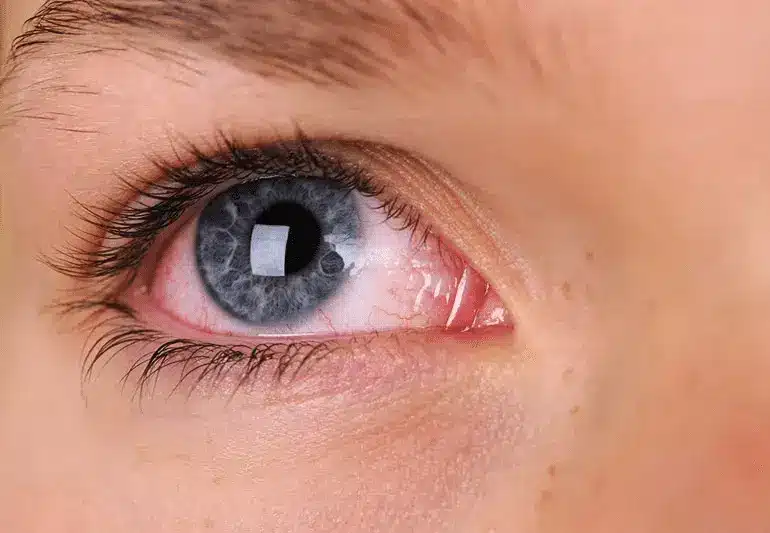Only for Licensed Professionals
Only for Licensed Professionals
.webp)
Tobradex Side Effects – The Complete List
David Fuller
Last Updated On: September 4, 2025
Prescription eye drops play a vital role in treating a wide range of eye conditions, from infections to post-surgical healing. Experts predict that by 2025, prescription products are estimated to make up more than 70% of the global eye drops market. This figure is a reflection of just how important they are for targeted treatment and recovery.
Among the commonly prescribed options is Tobradex, which combines tobramycin (an antibiotic) and dexamethasone (a corticosteroid). This dual-action formula works to fight bacterial infections while also easing the inflammation that often makes them painful and disruptive.
Like all medications, though, Tobradex can cause side effects. Some are mild and temporary, while others are rare but may require medical attention. In this article, we’ll go through the complete list of Tobradex side effects so you’ll know what to expect, when to be reassured, and when to seek professional advice.
Key Takeaways
- Tobradex may cause mild reactions such as eye irritation, burning, temporary blurred vision, and mild eyelid swelling, which are often temporary.
- Most side effects are not serious and usually subside as the eyes adjust; however, monitoring is essential.
- Some patients may experience moderate side effects like headache, light sensitivity, or allergic reactions, necessitating prompt consultation with a healthcare provider.
- Prolonged use of Tobradex can lead to serious complications such as increased intraocular pressure, cataract formation, or secondary infections.
- It’s crucial to use Tobradex under strict medical guidance to minimize risks and manage side effects effectively.
- Patients using Tobradex for over ten days should attend follow-up visits to monitor eye pressure and overall health.
- If moderate or severe side effects occur, patients may need to discontinue the medication or consider alternative treatments.
- Adhering to prescribed dosing is crucial for minimizing discomfort and ensuring the effective treatment of infections, such as conjunctivitis.
About: Operating since 2016, Med Supply Solutions is known for being one of the industry’s top and trusted suppliers of cosmetic and viscosupplementation products. If you’re looking to buy Tobradex online, contact our sales department for more information.

Common Side Effects of Tobradex Eye Drops

When beginning treatment with Tobradex, many patients notice mild side effects that tend to improve once the eyes adapt to the medication. These reactions are generally short-lived, but being aware of them helps patients set expectations and follow the treatment plan more confidently. While most are not dangerous, they can still be bothersome and should be monitored.
The most common side effects include:
- Eye irritation, including redness, burning, or stinging shortly after use.
- Temporary blurred vision, which usually clears within minutes of instilling the drops.
- Watery or itchy eyes, often due to mild sensitivity to the formulation.
- Eyelid swelling, which is usually mild and transient.
- Increased tearing, linked to changes in the eye’s surface response to treatment.
These effects, though inconvenient, rarely indicate a serious issue. For patients prescribed Tobradex for conjunctivitis, following the correct dosage and the physician’s instructions helps reduce discomfort and improve tolerance. If side effects linger or worsen, an eye specialist should be consulted.
Less Common and Moderate Adverse Reactions from Tobradex

While most individuals tolerate Tobradex well, some may experience less common reactions that can interfere with comfort or daily activities. These are not as frequent as mild irritation but deserve attention if they persist.
Less commonly reported effects include:
- Headache or Dizziness: Rarely reported, these may occur if medication drains into the nasal passages and enters systemic circulation. Though uncommon, they can be unsettling and warrant reporting.
- Light Sensitivity (Photophobia): With prolonged use, patients may experience increased discomfort in bright light, making activities such as reading or driving more challenging without sunglasses or protective eyewear.
- Allergic Reactions: Most are localized, presenting as eyelid redness, rash, or swelling. Systemic allergic responses are sporadic but should not be ignored.
- Foreign Body Sensation: Sometimes described as a gritty or sandy feeling, this ocular discomfort can discourage consistent use if not managed.
- Excessive Dryness: Not a primary listed effect, but may develop in some patients, particularly with prolonged use or sensitivity to preservatives.
Although these reactions are less common, they can disrupt recovery. Patients should not dismiss them if they interfere with vision or daily function. Reporting symptoms promptly allows clinicians to adjust or switch therapy when necessary.
Serious Risks and Long-Term Complications of Tobradex Use
Tobradex is an effective therapy, but like any steroid-containing medication, prolonged or unsupervised use can lead to serious complications. These effects are rare but significant enough to require close medical oversight.
- Increased Intraocular Pressure (IOP): The corticosteroid component may elevate eye pressure, raising the risk of glaucoma. Without detection, this can damage the optic nerve and reduce vision over time.
- Cataract Formation: Long-term steroid exposure is associated with clouding of the lens, resulting in blurred or hazy vision that may only be corrected with surgery.
- Secondary Eye Infections: By suppressing immune defenses, steroids can increase susceptibility to fungal or viral eye infections, which are harder to treat.
- Corneal Thinning or Perforation: In rare cases, weakened corneal tissue may become vulnerable, particularly if there is pre-existing damage.
- Severe Allergic Response: Most allergic reactions remain localized, but in extremely rare cases, systemic reactions with swelling of the face or breathing difficulty may occur and require immediate medical attention.
Because these complications often develop slowly, patients using Tobradex for more than ten days are usually advised to return for follow-up visits. Monitoring eye pressure and examining the lens during treatment helps catch problems early.
Monitoring, Management, and Patient Counseling for Tobradex Side Effects
Proper education and supervision help prevent complications. Patients should always follow the exact Tobradex dosing and application frequency prescribed by their doctor. Key counseling points include:
- Wash hands thoroughly before applying the drops or ointment.
- Avoid contact lenses during treatment to prevent worsening infection or irritation.
- Complete the full prescribed course, even if symptoms improve sooner.
- Keep the bottle tip sterile by avoiding contact with the eye, lashes, or skin.
- Report side effects that persist or worsen, rather than waiting for them to subside.
Follow-up visits are crucial for guaranteeing patient safety. Ophthalmologists may check for elevated eye pressure, signs of cataracts, or delayed wound healing. Patients who understand what to expect and how to manage their treatment are better equipped to use Tobradex responsibly and achieve the best possible outcome.
Conclusion
Tobradex remains a trusted option for treating bacterial eye conditions where infection and inflammation occur together. However, like all medications, it carries the possibility of side effects. These range from mild irritation and blurred vision to rare but serious complications such as glaucoma, cataracts, or corneal thinning.
Understanding the full spectrum of Tobradex side effects allows patients to use the medication safely and confidently. With medical supervision, adherence to instructions, and regular monitoring, Tobradex can support healing while minimizing risks.
FAQs
1. How long can I use Tobradex safely?
Most prescriptions last 7–10 days. Longer use raises risks like cataracts and glaucoma, so duration should follow a doctor’s plan.
2. Can Tobradex cause blurred vision?
Yes. Temporary blurred vision is common after applying the eye drops and usually resolves within a few minutes.
3. Are Tobradex side effects permanent?
Most are temporary, but long-term misuse may cause lasting issues like cataracts or glaucoma.
4. Can I self-medicate with Tobradex?
No. Because it contains a steroid, Tobradex should only be used under medical supervision to avoid unnecessary risks.
References
Patil V. Eye Drops market size and YOY growth rate, 2025-2032. Coherent Market Insights. Published July 17, 2025. https://www.coherentmarketinsights.com/industry-reports/eye-drops-market
Tobradex: Uses, Dosage & Side Effects. Drugs.com. https://www.drugs.com/tobradex.html
Tobradex: Package insert / prescribing information. Drugs.com. https://www.drugs.com/pro/tobradex.html
Products
Cart
Log In
Newsletter
Subscribe for exclusive offers and updates on new arrivals
Share feedback at:
Working Hours
MON - SUN 9AM to 6PM EST
The Most Popular Brands
Med Supply Solutions
Support
Secure checkout is guaranteed with full adherence to PCI DSS payment standards.
Products listed here are guaranteed authentic and manufacturer-sourced.
Pay easily with trusted providers


*Google and Apple Pay are currently only available via a direct link provided by your account manager.
Copyright 2025. Med Supply Solutions